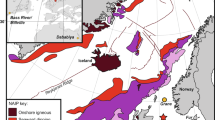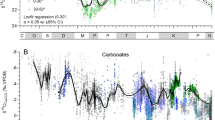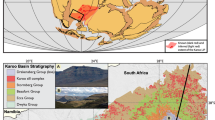Abstract
The Early Eocene Climatic Optimum (53–50 million years ago) was preceded by approximately six million years of progressive global warming1. This warming was punctuated by a series of rapid hyperthermal warming events triggered by the release of greenhouse gases1,2,3,4,5,6,7. Over these six million years, the carbon isotope record suggests that the events became more frequent but smaller in magnitude3,5,6,7. This pattern has been suggested to reflect a thermodynamic threshold for carbon release that was more easily crossed as global temperature rose, combined with a decrease in the size of carbon reservoirs during extremely warm conditions8,9,10,11. Here we present a continuous, 4.25-million-year-long record of the stable isotope composition of carbonate sediments from the equatorial Atlantic, spanning the peak of early Eocene global warmth. A composite of this and pre-existing7,12 records shows that the carbon isotope excursions that identify the hyperthermals exhibit continuity in magnitude and frequency throughout the approximately 10-million-year period covering the onset, peak and termination of the Early Eocene Climate Optimum. We suggest that the carbon cycle processes behind these events, excluding the largest event, the Palaeocene–Eocene Thermal Maximum (about 56 million years ago), were not exceptional. Instead, we argue that the hyperthermals may reflect orbital forcing of the carbon cycle analogous to the mechanisms proposed13,14 to operate in the cooler Oligocene and Miocene.
This is a preview of subscription content, access via your institution
Access options
Subscribe to this journal
Receive 12 print issues and online access
$259.00 per year
only $21.58 per issue
Buy this article
- Purchase on Springer Link
- Instant access to full article PDF
Prices may be subject to local taxes which are calculated during checkout



Similar content being viewed by others
References
Zachos, J. C., Dickens, G. R. & Zeebe, R. E. An early Cenozoic perspective on greenhouse warming and carbon-cycle dynamics. Nature 451, 279–283 (2008).
Thomas, E., Zachos, J. C. & Bralower, T. J. in Warm Climates in Earth History (eds Huber, B., MacLeod, K. & Wing, S.) 132–160 (Cambridge Univ. Press, 2000).
Cramer, B. S., Wright, J. D., Kent, D. V. & Aubry, M. P. Orbital climate forcing of δ13C excursions in the late Paleocene–early Eocene (chrons C24n-C25n). Paleoceanography 18, 1097 (2003).
Lourens, L. J. et al. Astronomical pacing of late Palaeocene to early Eocene global warming events. Nature 435, 1083–1087 (2005).
Nicolo, M. J., Dickens, G. R., Hollis, C. J. & Zachos, J. C. Multiple early Eocene hyperthermals: Their sedimentary expression on the New Zealand continental margin and in the deep sea. Geology 35, 699–702 (2007).
Galeotti, S. et al. Orbital chronology of Early Eocene hyperthermals from the Contessa Road section, central Italy. Earth Planet. Sci. Lett. 290, 192–200 (2010).
Zachos, J. C., McCarren, H., Murphy, B., Rohl, U. & Westerhold, T. Tempo and scale of late Paleocene and early Eocene carbon isotope cycles: Implications for the origin of hyperthermals. Earth Planet. Sci. Lett. 299, 242–249 (2010).
DeConto, R. M. et al. Past extreme warming events linked to massive carbon release from thawing permafrost. Nature 484, 87–91 (2012).
Dickens, G. R. Rethinking the global carbon cycle with a large, dynamic and microbially mediated gas hydrate capacitor. Earth Planet. Sci. Lett. 213, 169–183 (2003).
Komar, N., Zeebe, R. E. & Dickens, G. R. Understanding long-term carbon cycle trends: The late Paleocene through the early Eocene. Paleoceanography 28, 650–652 (2013).
Lunt, D. J. et al. Orbital pacing of methane hydrate destabilization during the Paleogene. Nature Geosci. 4, 775–778 (2011).
Sexton, P. F. et al. Eocene global warming events driven by ventilation of oceanic dissolved organic carbon. Nature 471, 349–352 (2011).
Pälike, H. et al. The heartbeat of the Oligocene climate system. Science 314, 1894–1898 (2006).
Holbourn, A., Kuhnt, W., Schulz, M., Flores, J-A. & Andersen, N. Orbitally-paced climate evolution during the middle Miocene “Monterey” carbon isotope excursion. Earth Planet. Sci. Lett. 261, 534–550 (2007).
Quillévéré, F., Norris, R. D., Kroon, D. & Wilson, P. A. Transient ocean warming and shifts in carbon reservoirs during the early Danian. Earth Planet. Sci. Lett. 265, 600–615 (2008).
Sexton, P. F., Wilson, P. A. & Norris, R. D. Testing the Cenozoic multisite composite δ18O and δ13C curves: New monospecific Eocene records from a single locality, Demerara Rise (Ocean Drilling Program Leg 207). Paleoceanography 21, PA2019 (2006).
Westerhold, T. et al. On the duration of magnetochrons C24r and C25n and the timing of early Eocene global warming events: Implications from the Ocean Drilling Program Leg 208 Walvis Ridge depth transect. Paleoceanography 22, PA2201 (2007).
Agnini, C. et al. An early Eocene carbon cycle perturbation at ∼52.5 Ma in the Southern Alps: Chronology and biotic response. Paleoceanography 24, PA2209 (2009).
Westerhold, T. & Röhl, U. High resolution cyclostratigraphy of the early Eocene —new insights into the origin of the Cenozoic cooling trend. Clim. Past 5, 309–327 (2009).
Westerhold, T., Röhl, U. & Laskar, J. Time scale controversy: Accurate orbital calibration of the early Paleogene. Geochem. Geophys. Geosyst. 13, Q06015 (2012).
Laskar, J., Fienga, A., Gastineau, M. & Manche, H. La2010: A new orbital solution for the long-term numerical solution for the long term motion of the Earth. Astron. Astrophys. 532, A89 (2011).
Cramer, B. S., Toggweiler, J. R., Wright, J. D., Katz, M. E. & Miller, K. G. Ocean overturning since the Late Cretaceous: Inferences from a new benthic foraminiferal isotope compilation. Paleoceanography 24, PA4216 (2009).
Dickens, G. R. Down the Rabbit Hole: Toward appropriate discussion of methane release from gas hydrate systems during the Paleocene–Eocene thermal maximum and other past hyperthermal events. Clim. Past 7, 831–846 (2011).
Russon, T., Paillard, D. & Elliot, M. Potential origins of 400–500 kyr periodicities in the ocean carbon cycle: A box model approach. Global Biogeochem. Cycles 24, GB2013 (2010).
Herbert, T. D. A long marine history of carbon cycle modulation by orbital-climatic changes. Proc. Natl Acad. Sci. USA 94, 8362–8369 (1997).
Shipboard Scientific Party in Proc. ODP, Init. Repts. (eds Erbacher, J. et al.) Vol. 207 (Ocean Drilling Program, 2004).
Acknowledgements
S.K.T. thanks D. Lunt for his generous help with setting up the threshold model. This research used samples and data provided by the ODP. ODP (now IODP) is sponsored by the US NSF and participating countries under the management of JOI, Inc. Financial support for this research was provided by a National Science Foundation International Research Fellowship (to S.K.T.).
Author information
Authors and Affiliations
Contributions
S.K.T. developed the bulk carbonate stable isotope records with the assistance of C.D.C., designed and ran the threshold model experiments, and created the composite δ13C record and method for identifying hyperthermals. S.K.T. and P.F.S. wrote the manuscript. S.K.T. and R.D.N. developed Fig. 1. P.F.S. produced Supplementary Fig. 6. All authors contributed to the final text.
Corresponding author
Ethics declarations
Competing interests
The authors declare no competing financial interests.
Supplementary information
Supplementary Information
Supplementary Information (PDF 3105 kb)
Supplementary Information
Supplementary Information (XLSX 123 kb)
Rights and permissions
About this article
Cite this article
Kirtland Turner, S., Sexton, P., Charles, C. et al. Persistence of carbon release events through the peak of early Eocene global warmth. Nature Geosci 7, 748–751 (2014). https://doi.org/10.1038/ngeo2240
Received:
Accepted:
Published:
Issue Date:
DOI: https://doi.org/10.1038/ngeo2240
This article is cited by
-
Astrochronology of the Paleocene-Eocene Thermal Maximum on the Atlantic Coastal Plain
Nature Communications (2022)
-
Warm deep-sea temperatures across Eocene Thermal Maximum 2 from clumped isotope thermometry
Communications Earth & Environment (2022)
-
Very large release of mostly volcanic carbon during the Palaeocene–Eocene Thermal Maximum
Nature (2017)



